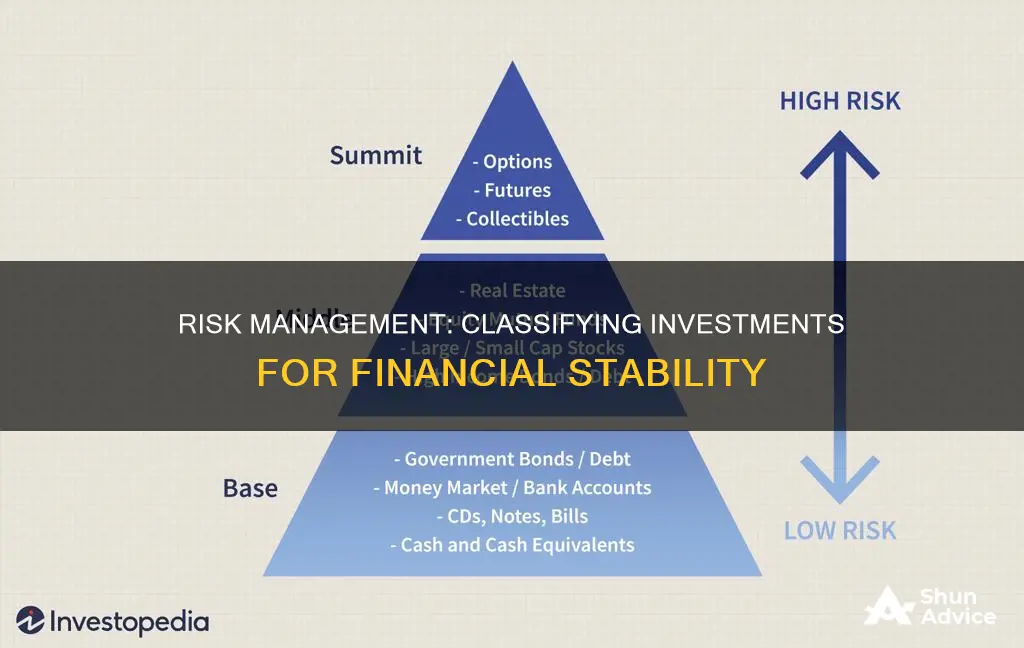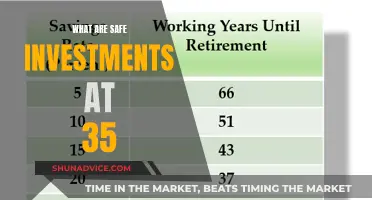
Investment risk refers to the likelihood of financial losses when the actual returns on an investment differ from the anticipated ones. This risk stems from the inherent uncertainty of financial markets, where factors such as economic fluctuations, changes in interest rates, political instability, or company performance can lead to a decline in the value of securities. Generally, investments with a higher risk quotient yield better returns. There are two broad categories of investment risk: systematic risk and unsystematic risk. Systematic risk, also known as market risk, affects the entire economic market or a large percentage of it. It includes interest rate risk, inflation risk, currency risk, liquidity risk, and sociopolitical risk. On the other hand, unsystematic risk, also called specific or idiosyncratic risk, affects only a particular industry or company. Examples include business risk, financial risk, default risk, and liquidity risk.
| Characteristics | Values |
|---|---|
| Type of Risk | Systematic Risk, Unsystematic Risk |
| Systematic Risk Types | Market Risk, Interest Rate Risk, Purchasing Power/Inflation Risk, Currency Risk, Reinvestment Rate Risk |
| Unsystematic Risk Types | Business Risk, Financial Risk, Default Risk, Downgrade Risk, Liquidity and Marketability Risk, Event Risk |
| Risk Factors | Default Risk, Liquidity Risk, Market Price Risk, Inflation Risk, Exchange Rate Risk |
| Risk Classes | 7 Classes, from Safe (1) to Speculative (7) |
| Risk Management Strategies | Diversification, Long-Term Investment Horizons, Averaging |
| Risk Assessment Tools | Standard Deviation, Sharpe Ratio, Beta, Value at Risk, R-squared |
What You'll Learn

Systematic and Unsystematic Risk
Investment risk can be divided into two types: systematic risk and unsystematic risk. Systematic risks are those that affect the financial market as a whole, whereas unsystematic risks are unique to a specific company, industry, or sector. Both types of risks are unavoidable but can be managed through diversification and asset allocation strategies.
Systematic Risk
Systematic risk, also known as market risk, is the uncertainty that affects many investments. It is typically caused by macroeconomic factors such as inflation, exchange rates, political instability, and natural disasters. These risks are inherent in the stock market and cannot be diversified away. Systematic risks include interest rate risk, market risk, purchasing power risk, and currency risk. They are considered non-diversifiable, meaning that organisations and investors cannot control, minimise, or avoid them. However, their effects can be mitigated through proper asset allocation and hedging techniques.
Unsystematic Risk
Unsystematic risk, also known as specific risk, diversifiable risk, or residual risk, is specific to a particular company, industry, or investment. It arises due to internal and external factors that do not affect the entire market. Examples of unsystematic risk include changes in management, regulatory changes, labour unrest, and raw material shortages. Unsystematic risk can be controlled, minimised, or possibly avoided through diversification strategies. It is the portion of total risk that is unique to a firm, industry, or property.
Total Risk
Total risk is the combination of systematic and unsystematic risk. While systematic risk is inherent in the market and affects all investments, unsystematic risk is specific to individual companies or industries and can be reduced through diversification. Both types of risks must be assessed when making investment decisions, as they can impact the performance and volatility of investments.
Sustainable Investing: Managing Environmental Risks and Creating Value
You may want to see also

Market Risk
- Changes in interest rates
- Exchange rates
- Geopolitical events
- Recessions
- Political turmoil
- Natural disasters
- Terrorist attacks
- Inflation
The standard deviation of changes in the prices of stocks, currencies, or commodities is referred to as price volatility. Volatility is often presented in annualised terms and may be expressed as an absolute number or a percentage of the initial value.
The most common types of market risks include:
- Interest rate risk: This arises from fluctuations in interest rates due to central bank announcements related to monetary policy changes. It is most relevant to investments in fixed-income securities, such as bonds.
- Equity risk: This is the risk involved in the changing prices of stock investments.
- Commodity risk: This covers the changing prices of commodities such as crude oil and corn.
- Currency risk: Also known as exchange-rate risk, this arises from changes in the price of one currency relative to another. It affects investors or firms holding assets in another country.
- Country risk: This refers to the risk that a country will not be able to honour its financial commitments, impacting the performance of financial instruments within that country.
Understanding Managed Investments: What Are Listed Managed Investments?
You may want to see also

Credit Risk
Bonds with a lower chance of default are considered investment-grade, while bonds with higher chances are considered high-yield or junk bonds.
Equilibrium Economics: Savings-Investment Identity
You may want to see also

Liquidity Risk
For example, a company may face funding liquidity risk if it is unable to secure short-term funding at favourable terms during periods of financial turbulence. This could force the company to sell assets at a loss, further weakening its financial position and deterring potential lenders or investors.
Effective liquidity risk management involves ensuring the availability of sufficient cash, liquid assets, and accessible borrowing lines to meet both expected and unexpected liquidity needs. This can be achieved through strategies such as maintaining a portfolio of high-quality liquid assets, rigorous cash flow forecasting, and diversifying funding sources.
The consequences of poorly managed liquidity risk can be severe and may lead to financial losses, operational disruptions, and reputational damage. In extreme cases, liquidity risk can even drive an entity towards insolvency or bankruptcy.
Building a Wine Investment Portfolio: A Beginner's Guide
You may want to see also

Foreign Investment Risk
Another aspect of foreign investment risk is the lack of information and transparency regarding investments in some countries. The rules and regulations governing publicly traded assets may differ from those in the United States, making it challenging to access reliable information for investment decisions.
Additionally, foreign investments may face potential liquidity issues. There could be limited demand from other investors for certain foreign assets, making it difficult to sell those assets when needed.
It is important to note that foreign investments can provide benefits such as diversification. However, they may also come with higher transaction costs. Understanding these risks and one's own risk tolerance is crucial before investing in foreign stocks, bonds, or real estate.
Tyson Ranch: Where to Invest in the Future
You may want to see also
Frequently asked questions
Investment risk refers to the possibility of losing some or all of the money invested due to adverse market movements or other unforeseen circumstances. It is associated with the inherent uncertainty of financial markets, where factors such as economic fluctuations, changes in interest rates, political instability, or company performance can lead to a decline in the value of securities.
Your risk tolerance is the amount of risk you are willing to accept with your investments. This is influenced by factors such as your investment goals, income, liquidity needs, time horizon, and personality. It's important to understand your risk tolerance before making investment decisions.
While investment risks cannot be completely eliminated, there are strategies to manage them, including diversification, long-term investment horizons, and averaging. Diversification is a key strategy, which involves spreading your investments across various asset classes, sectors, and industries to reduce your overall risk exposure.







